柄香炉が使われる場面に遭遇しました。(愛知県名古屋市千種区姫池通 骨董買取致します 古美術風光舎名古屋店)
2021.10.24
こんにちは、スタッフYです。
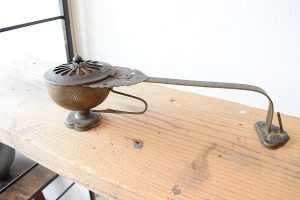
日々、古美術に触れていますと、必然的に歴史のお勉強や当時の文化、生活様式、流行っていたものなどを知る機会は多いのですが、わたくしの知識が薄いせいか、「はて、これはどうやって使っていたのだろうか?」と、いう場面もよくございます。まだまだ、古美術を語るまではいきそうにないですね。
それはそうと、先日ウォーキングを兼ねまして、あるお寺巡りいやいやもはや登山でしたでしょうか、奈良にあります長谷寺に行く機会がございました。
長谷寺については、有名なお寺ですからご存じの方もいらっしゃるのではと思いますので、また別の日にふれると致しまして、その日ちょうど訪れた時に檀家さんらしき方の法要が執り行われておりました。
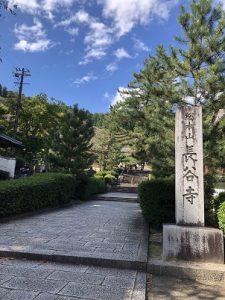
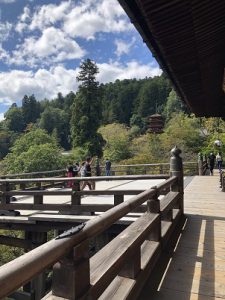
法要も終わったのでしょうかお坊様が立ち上がりました。立ち上がった手には、柄香炉をお持ちではないですか。初めて実際に柄香炉を使っている様子に遭遇。私の実家の地区ですと、法要は自宅にお寺さんをお迎えすることが多いので、そのような場面に遭遇することが無く、はじめて近くで見ることができ、しっかりみさせていただきました。
薄暗い御堂の中、柄香炉を丁寧に持ち、微かなお香の煙と共に奥へ入っていかれるお坊さん。一連の流れるような所作が、とても美しくしばし見とれており、大きな十一面観音立像の前で、静かに繰り広げられる美しい一場面が切り取られた絵のようでした。
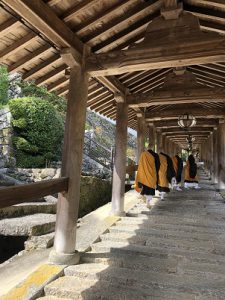
そんな柄香炉ですが、実際に見に行くことはできませんでしたが今年の夏に東京国立博物館にて特別展「聖徳太子と法隆寺展」が開かれておりました時に、国宝の「鵲尾形柄香炉」飛鳥時代(東京国立博物館所蔵 法隆寺献納宝物)が展示されていたようです。柄の末端が三つに分かれて鵲(かささぎ)の尾に似ているため、この名称がついたようで、こちらの柄香炉はデザインがいたってシンプル。実際に鑑賞してみたかったですね。
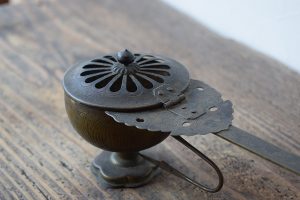
そもそも柄香炉は手炉ともいい、手に執って薫香を仏に献ずる仏具ですが、そのはじまりは仏教誕生の地である古代インド。うやまうべき神や人に対して、花をたむけ、お香をたき、火をささげる風習からはじまっております。これが仏教にも取り入れられた結果、花・香・火の3つは、仏像にささげる最も基本的な3つの供物(そなえもの)と考えられるようになりました。このため、仏教では香をたく道具である香炉(こうろ)が、早くから使用されており、その香炉に持ち手である「柄」(え)をつけたものが柄香炉です。
柄香炉は仏教の僧侶が持っておくべき道具の一つに挙げられるほど、大事なものとされ、仏教にかかわる道具の中では長い歴史をもちます。インドで発生した仏教が、中国や朝鮮半島を経由して日本に伝来したのは、6世紀中ごろとされており、さきほどお伝えしたように日本に現存する最古の作品は、現在東京国立博物館の法隆寺献納宝物の中にある飛鳥時代7世紀の柄香炉でして、おそらく、さほど間を置かずに仏教伝来とともに日本にもたらされたと推測されます。
柄香炉のデザインは様々なのですが、大まかな特徴としては、銅を鋳造してパーツを作り、接合して仕上げております。口がアサガオ状に開いた容器の部分が香を入れる炉であり、その下には花形の座があって炉を支えています。炉には長い柄を取り付け、炉の縁(ふち)と柄が接する部分に、2個の丸い飾りのある銅板をつけています。柄の先は90度に曲げ、獅子をかたどった「鎮」(ちん)つまり「重(おも)し」を据えています。重しといいながら、装飾の意味あいが強いものです。獅子は前足をふんばり、尻尾(しっぽ)を高く上げ、力強い姿にあらわされます。
実は、当店にも柄香炉がございまして、この特徴をふまえてあらてめて鑑賞していたのですが、当店の柄香炉は、細やかな蓮の花のような彫が入っており、優しいデザインでしょうか。炉の蓋をあけてみますと、中には微かに残っている灰が。かつて漂っていたであろうお香の煙の一筋を思い起こさせます。どのようなところで使われていたのか、実に気なりますね。それでは、また。
Hello, this is Staff Y When I come into contact with antique art every day, I inevitably have many opportunities to study history and learn about the culture, lifestyle, and trends of the time. , How did you use this? ” I haven’t gotten to talk about antique art yet, lol.
That being said, I had the opportunity to go to Hase-ji Temple in Nara, perhaps because I was walking around a certain temple the other day, or maybe I was climbing a mountain. As for Hase-dera, it is a famous temple, so I think some of you may know it, so I decided to touch it on another day, and when I visited that day, the memorial service of the Danya-san was held. ..
I wonder if the memorial service is over, the priest stood up. Do you have a patterned incense burner in your raised hand? For the first time, I encountered the appearance of actually using the incense burner. At my parents’ house, the memorial service often welcomes a temple to my house, so I was very lucky to have never encountered such a scene.
A Buddhist priest who carefully holds a patterned incense burner in a dimly lit temple and enters the interior with a faint incense smoke. A series of flowing actions was very beautiful and often admired. In front of the large eleven-faced Kannon statue, it was like a picture of a beautiful scene that unfolds quietly.
Although I couldn’t actually go to see such a pattern incense furnace, when the special exhibition “Saintokutaiko and Horyuji Exhibition” was held at the Tokyo National Museum this summer, the national treasure “Uogata pattern” It seems that the “Incense Furnace” Asuka period (a treasure dedicated to Horyuji Temple in the collection of the Tokyo National Museum) was on display. It seems that this name was given because the end of the handle is divided into three parts and resembles the tail of a magpie, and this pattern incense burner has a very simple design. I really wanted to see it.
In the first place, the patterned incense burner is also called a hand furnace, and it is a Buddhist tool that is held in the hand and offers Kaoru incense to the Buddha, but its beginning is ancient India, the birthplace of Buddhism. It begins with the custom of laying flowers, burning incense, and offering fire to gods and people who should be respected. As a result of this being incorporated into Buddhism, the three flowers, incense, and fire have come to be considered as the three most basic offerings (offerings) dedicated to Buddhist statues. For this reason, incense burners, which are tools for burning incense, have been used in Buddhism from early on, and incense burners with a handle, “handle”, are attached to the incense burner.
The pattern incense burner is so important that it is one of the tools that Buddhist monks should have, and it has a long history among the tools related to Buddhism. It is said that Buddhism that originated in India was introduced to Japan via China and the Korean Peninsula in the middle of the 6th century, and as I mentioned earlier, the oldest existing work in Japan is now at the Tokyo National Museum. It is a pattern incense furnace in the 7th century of the Asuka period, which is one of the treasures dedicated to Horyuji Temple, and it is presumed that it was brought to Japan with the introduction of Buddhism in a short time.
There are various designs for the patterned incense burner, but the general feature is that copper is cast to make parts, and they are joined and finished. The part of the container with the mouth open like a morning glory is the furnace for incense, and underneath it is a flower-shaped seat that supports the furnace. A long handle is attached to the furnace, and two round copper plates are attached to the part where the handle touches the edge of the furnace. The tip of the handle is bent 90 degrees, and a lion-shaped “chin”, that is, a “heavy” is placed. Although it is said to be heavy, it has a strong meaning of decoration. The lion has a powerful appearance with its front legs fluffy and its tail raised high.
Actually, our shop also has a patterned incense burner, and I was appreciating it based on this feature, but our patterned incense burner has a delicate lotus flower-like carving and a gentle design. is not it.
When I opened the lid of the furnace, there was a slight amount of ash left inside.
It reminds me of a line of incense smoke that would have drifted in the past.
I really wonder where it was used.
See you again.
**********************
お寒くなってまいりました。冬物の入れ替えや、整理をされていらっしゃる方もおいでではないでしょうか。
生活様式の変化とともに、大切なお品を整理されている方も多いことと思われます。
ここ風光舎では、古美術品や骨董品の他にも絵画や宝石、趣味のお品など様々なジャンルのものを買受しております。
お片付けをされていて、こういうものでもいいのかしらと迷われているものでも、どうぞお気軽にご相談下さいませ。
風光舎は、出張買取も強化しております。
愛知県内はもちろん、岐阜県・三重県その他の県へも出張いたします。
どんなにご近所の方でもお伺いできますので、まずはお電話お待ちしております。
愛知県名古屋市千種区・骨董 買取
『古美術 風光舎 名古屋店』
TEL 052(734)8444
10:00-17:00 OPEN

